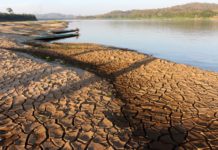
Water levels in the Mekong River have fallen to a “worrying level” in part due to outflow restrictions from Chinese hydropower dams upstream, the Mekong River Commission (MRC) said in February 2021, calling on Beijing to share all of its water data.
The vital waterway, pictured, has turned blue along the Laos-Thailand border from its usual murky brown — signaling shallow water and low levels of nutrition-rich sediment — partially from outflow restrictions from the Jinghong Dam in the People’s Republic of China’s (PRC’s) Yunnan province, the intergovernmental MRC said.
The February 12 statement said low rainfall and dams on the Lower Mekong and its tributaries also contributed to the drop in levels.
“There have been sudden rises and falls in water levels immediately downstream of Jinghong and further down to Vientiane” in Laos, said Winai Wongpimool, director of the MRC Secretariat’s Technical Support Division.
Such fluctuations affect fish migration, agriculture and transportation that nearly 70 million people rely on for their livelihoods and food security.
“To help the Lower Mekong countries manage risks more effectively, we call on China and the Lower Mekong countries themselves to share their water release plans with us,” Winai said.
The MRC said normal conditions may be restored if large volumes of water are released from Chinese dams’ reservoirs.
The PRC’s Ministry of Foreign Affairs disputed the MRC’s findings, adding that there are many causes of downstream drought.
The PRC in 2020 pledged to share data from it dams with MRC member countries Cambodia, Laos, Thailand and Vietnam.
In January 2021, Beijing notified neighbors that its dams were filling reservoirs until January 25.
Outflow levels at Jinghong were 785 cubic meters per second in early January before rising to 1,400 cubic meters per second in mid-January, the MRC said.
However, levels dropped again in February and were 800 cubic meters per second as of February 11, the MRC said. The statement did not mention any recent notification from Beijing.
The PRC said the dam’s outflow has been consistently more than 1,000 cubic meters per second since late January, a level it says is nearly twice the natural flow of the river. It called on the MRC “to avoid causing public misunderstanding.”








































